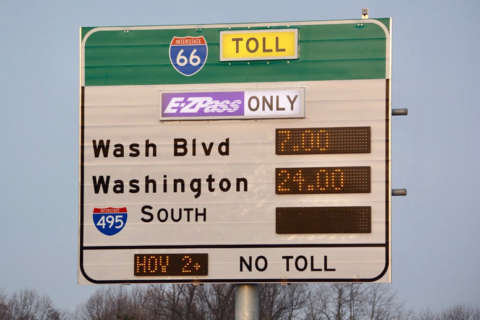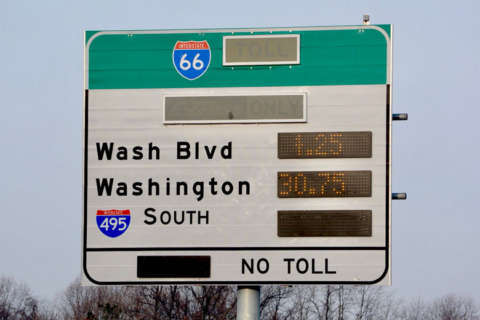WASHINGTON — As Virginia works out kinks in rush-hour tolling for solo drivers on Interstate 66 inside the Beltway nearly two months after it began, a House of Delegates subcommittee has effectively killed one of numerous legislative efforts to stop the tolls.
Republican Del. Dave LaRock’s proposal to cap monthly tolls for individual drivers at $200, revert to old HOV hours and toll drivers going opposite the worst rush hour traffic in addition to changes along the Dulles Toll Road and Dulles Access Road was voted down 7 to 3 in a House Transportation subcommittee early Tuesday morning.
Additional bills challenging I-66 tolling rules could be heard by the same subcommittee next week. The Northam administration warns that any changes to the tolling rules inside the Beltway now could require Virginia to pay a penalty to the private companies building the separate toll lanes outside the Beltway, since the contract for those lanes was based on Virginia’s existing plans.
VDOT trying to address tolling issues
While the Virginia Department of Transportation is satisfied with the overall tolling setup, Tolling Administrator David Caudill told WTOP they are still trying to work out problems with motorcycles wrongly being charged tolls and separate problems that have seen a handful of drivers charged even outside of the tolling hours.
Toll system operators are now manually reviewing every trip that might be by a motorcycle to ensure bikers ride free as promised.
The review is triggered either by a motorcycle-class E-ZPass registering or by the laser scanners that are supposed to confirm the size of the vehicle automatically.
“So we’re kind of not really trusting the automation at this point until we get it more refined,” Caudill said. “When you get human eyes on it, then it becomes obvious.”
The laser scanner system is being adjusted to work properly, but Caudill had no specific timeline for the fix.
“It’s a very complex system, lots of moving parts, and as we exercise the system we find things like this and we mitigate immediately. And then we do the more protracted process where we fix the automation so it’ll work better,” he said.
The operations team has found several instances where the system attempted to charge drivers who exited the lanes before the start of tolling hours (5:30 a.m. to 9:30 a.m. eastbound and 3 p.m. to 7 p.m. westbound).
While the charges that were caught did not post to E-ZPass accounts, WTOP listener Mike Irwin did appear to be wrongly charged $1 for a two-minute trip Dec. 14 that ended at 2:56:49 p.m., before tolls were supposed to begin.
“We did see an occasion where that was happening, and they put checks in to stop that,” Caudill said.
“I think we saw some get through, and we corrected them manually. If some got all the way to the E-ZPass, then if anybody sees that, just call us and we’ll make sure it gets fixed,” he added.
The key is that drivers must check E-ZPass statements carefully to catch any errors and dispute them.
In screenshots provided by Irwin, the Dec. 14 trip did not post on his account until Jan. 4. Some other trips posted in as few as two days.
More than 1 in 10 drivers getting violation tickets
A significant number of drivers on I-66 inside the Beltway when the HOV or tolling rules apply still do not have an E-ZPass, which means they are getting violation notices in the mail that carry additional charges.
At least 1 in 10 of the rush-hour drivers do not have an E-ZPass or an E-ZPass Flex, which means they get the violation notices in the mail (essentially traffic tickets that can significantly escalate if not paid), even if they have at least one other person in the car to meet HOV requirements.
Only cars with at least two people and an E-ZPass Flex switched to HOV mode or motorcycles ride free during the restricted hours.
Around 87 percent of drivers have an E-ZPass — that’s an increase from just before tolls began.
No changes to tolling algorithm yet
Virginia has not changed the tolling formula used to raise and lower prices based on the amount of traffic in the lanes.
The tolling group does not yet have enough historical data to justify any significant tweaks, Caudill said. Tolls began Dec. 4.
“December’s not the best month to do that, because of the holidays and just the lower traffic volumes overall, so the plan is to continue to monitor it very closely, then take the data that we start to see in a more routine pattern, feed that back in to the model, and then we’ll have a more accurate model to respond to potential pricing changes,” he said.
An internal group continues to analyze patterns based on time of day or day of the week to see if there are any opportunities to lower prices to lure more cars into the lanes without slowing traffic too much.
Tolls have reached $46.75 at the busiest times of morning rush hours. The morning rush tolls are higher in part because of the merge at the Dulles Connector Road.
“The dynamic pricing is based on congestion, and when it starts to go to those levels there is significant congestion and we are trying to raise it high enough that we can still maintain some sort of throughput through there,” Caudill said.
Even with some spikes in pricing for solo drivers, Caudill said, his team is pleased with how the system is working.
“Actually, we’re very pleased with the way the public is motivated to use it. You can tell by the pricing that there are some people that think it’s very valuable,” he said.







